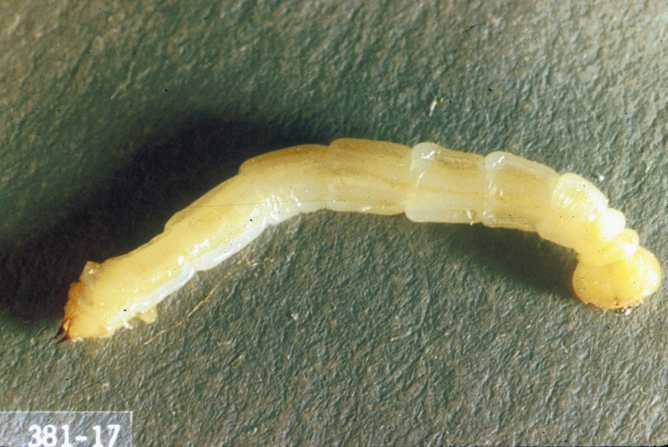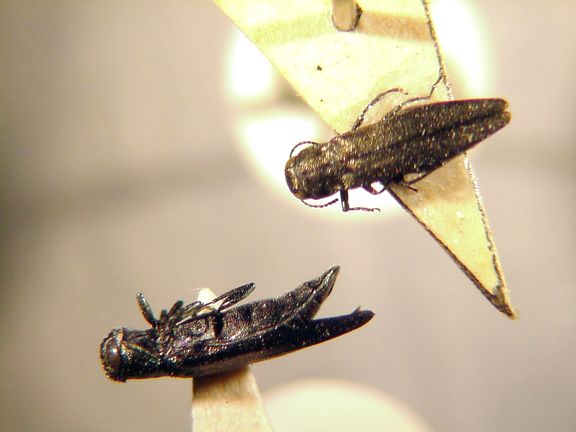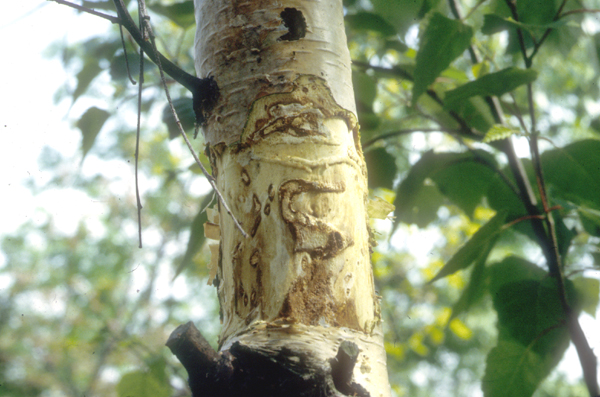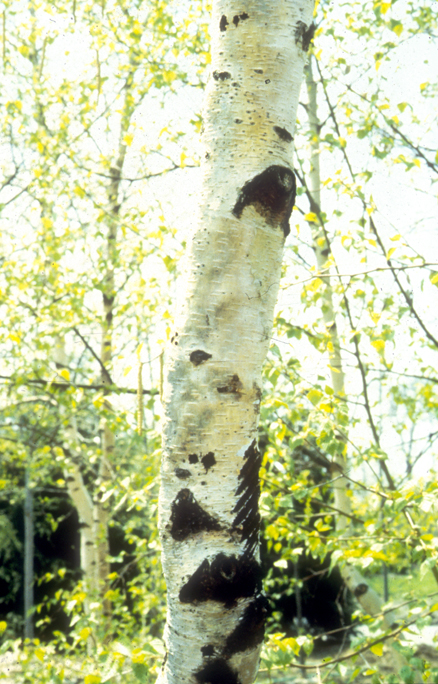Landscape & Ornamental
BRONZE BIRCH BORER
Timothy J. Gibb and Clifford S. Sadof, Extension Entomologists
If you want to view as pdf, click here
Chlorotic leaves, sparse foliage and dying upper branches of white, paper and yellow birch trees are often the first visible symptoms of bronze birch borer damage. Closer examination will reveal ridges and bumps on the limbs and branches as well as occasional D-shaped holes in the bark. Peeling back bark from infested trees will further reveal irregular, winding, sawdust-packed tunnels. It is these tunnels that girdle the branches and eventually kill trees. Trees that receive no corrective measures usually die within a few years after the first dead branches are found.
Bronze birch borer larva.
Bronze birch borer damage.
LIFE CYCLE
The bronze birch borer is a serious native insect pest. The adult is a black beetle about 1/2 inch long and has bronzy iridescence on the back. It is a sun-loving insect and may be found crawling on the sunny side of the trunk during late May and early June.
The female deposits her eggs under cracks and crevices of the bark. Eggs hatch in 2 weeks or less, and the slender larvae tunnel immediately into the phloem tissue to construct their galleries. They may occasionally tunnel into the xylem (wood) to molt and overwinter. One or two years may be required to complete larval development. The larvae pupate in the xylem in late April or early May. Adults fly when black locust trees bloom.
PREVENTING INFESTATIONS
By Maintaining Healthy Trees: Vigorously growing trees are less inclined to be damaged by borers than are trees in poor condition. Birch trees are relatively short-lived and thus old age, adverse weather conditions or other insect-related stresses can all contribute to weakened trees. Most ornamental trees are grown in lawns, which is not usually conducive to healthy, vigorous growth. In fact, lawn conditions are opposite the normal habitat of birch trees. Thus, birch trees are often in a weakened condition, making them attractive to the bronze birch borer.
By Using Resistant Varieties: One way to lessen chances of borer attack is to plant borer-resistant species like river birch, Japanese birch or the variety “Heritage”. Another way is to maintain healthy trees by watering.
Birches in lawns should be watered every 7-10 days IF rainfall amounts are less than 1 to 1 1/2 inches per week. To water properly, allow the garden hose to run beneath the tree for several hours so that plenty of moisture reaches the root zone.
Prevent defoliation and injury by controlling other birch tree pests such as aphids, scales, and leafminers.
CONTROLLING EXISTING INFESTATIONS
Sanitation: Remove dying trees and branches before adults emerge in early May. This can reduce the number of borers available to attack your trees.
Insecticide Sprays: Between mid-May and mid-June, homeowners can spray infested trees with permethrin (Eight) or Spectracide Bug Stop to kill adults emerging from bark and feeding on leaves. Commercial applicators can spray Astro EC (permethrin) or Onyx (bifenthrin).
Systemic Insecticide Sprays: A soil drench of systemic insecticides can be used to kill adults that feed on leaves and larvae beneath the bark. Soil applications of imidacloprid (Bayer Tree and Shrub Protect I, Xytect, and others) imidacloprid plus clothianidin (Bayer Tree and Shrub Protect II) can be made from between April 1 and May 15. Professionals can apply dinotefuran directly to the trunk or as a soil drench between May 1 and June 15.
Bronze birch borer adults.
Tunnels under bark from bronze birch borer feeding.
Bronze birch borer feeding will cause bark to appear bumpy.
READ AND FOLLOW ALL LABEL INSTRUCTIONS. THIS INCLUDES DIRECTIONS FOR USE, PRECAUTIONARY STATEMENTS (HAZARDS TO HUMANS, DOMESTIC ANIMALS, AND ENDANGERED SPECIES), ENVIRONMENTAL HAZARDS, RATES OF APPLICATION, NUMBER OF APPLICATIONS, REENTRY INTERVALS, HARVEST RESTRICTIONS, STORAGE AND DISPOSAL, AND ANY SPECIFIC WARNINGS AND/OR PRECAUTIONS FOR SAFE HANDLING OF THE PESTICIDE.
November 2017

It is the policy of the Purdue University Cooperative Extension Service that all persons have equal opportunity and access to its educational programs, services, activities, and facilities without regard to race, religion, color, sex, age, national origin or ancestry, marital status, parental status, sexual orientation, disability or status as a veteran. Purdue University is an Affirmative Action institution. This material may be available in alternative formats.
This work is supported in part by Extension Implementation Grant 2017-70006-27140/ IND011460G4-1013877 from the USDA National Institute of Food and Agriculture.
1-888-EXT-INFO
www.extension.purdue.edu
Order or download materials from www.the-education-store.com







